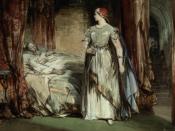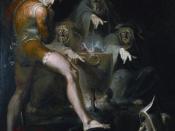Macbeth
In the novel Macbeth, written by William Shakespeare, the idea that appearances can be deceptive is presented as a major theme throughout the play. It is first introduced by the witches. Later on, it is presented through Macbeth himself, and also Lady Macbeth.
The three witches first introduce the theme in Act one, Scene one with their closing statement: "Fair is foul, and foul is fair." This introduces the idea of deceptiveness of appearances throughout the whole play. This particular quote means that what is good is bad, and what is bad is good. They begin to tell Macbeth that if he murders the King, he himself will take his rein. In other words, they are telling him that it's okay to kill the King because in the end, he will receive his title. In Act one Scene three, the three witches give Macbeth the title of "king hereafter".
Soon after they leave, two Scottish noblemen come in and announce to Macbeth that the King has named him "Thane of Cawdor". He contemplates killing King Duncan in order to become "king hereafter" as the witches called him. Once again, the witches introduced this idea to Macbeth getting him to believe that it was a positive one. But really, what came of it wasn't really so positive.
Although he seems very innocent, Macbeth is a pure example of the theme 'appearances can be deceptive'. In Act one, Scene three Macbeth says, "And nothing is but what is not." He has been thinking about murdering the King and the picture of himself as the murderer is so vivid that he is not capable of seeing anything around him. In Act two, Scene one, he says, "...and withered murder, Alarumed by his sentinel, the wolf, Whose howl's his watch, thus...



Structure
Very nice idea's and such but this somewhat lacks structure.
Try structuring your paragraphs in a SEET type fashion.
S = Statement.
E = Explain your statement
E = Give examples and quotes to prove this.
T = Tell More. What is the authors purpose, How is this achieved, Impact on audience, and such things like that.
0 out of 0 people found this comment useful.